December 29, 2012
by Carole Zangari -
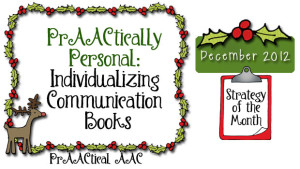
Custom tailored suit or off the shelf? Shoes that pinch or ones that are just snug? It stands to reason that when something fits well, we are more likely to wear it. Communication books, like clothes, have to ‘fit’ the user. But what does that really mean? When we’re ‘tailoring’ a communication book for someone who is learning to use AAC, there are three areas that we think about: How it looks, what it has inside, and how it ‘sounds.’ Appearance & Aesthetics As we’ve said before, everyone deserves communication tools that look great. Communication books should reflect the style and personality of the person who’ll be using it. Customizing a communication book doesn’t need to be expensive. You can use special papers for the cover or pages, and stickers to decorate. Here are some ideas to get you started. Send them shopping: There’s nothing that speaks to ownership like... [Read More...]
Filed under: Strategy of the Month
Tagged With: aesthetics, appearance, COmmunication Books, customize, hobbies, individualize, interests, style
December 22, 2012
by Robin Parker -
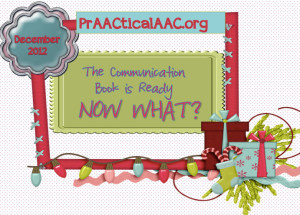
The Communication Book is Ready… Now What? The fun begins…. Yes, we really do think that TEACHING a learner to USE the communication book is FUN. We get to participate in lots of meaningful language experiences, we get to be creative, we get to watch language blossom, and we get to be surprised by the communication competence ALL of our learners show us after prAACtice, prAACtice, and for some more prAACtice . The best way to get started with communication book teaching is to begin by trying out different teaching tips, strategies, and resources and find out what works best. Each communication dyad (communicator & communication partner) is different so the combination of strategies that will work will vary but at the core of the teaching process, there should be fun, motivation, and of course progress. STRATEGIES and CONSIDERATIONS Aided Language Input (ALI)– We can not say enough about... [Read More...]
Filed under: Strategy of the Month
Tagged With: COmmunication Books, resources, tips
December 15, 2012
by Carole Zangari -
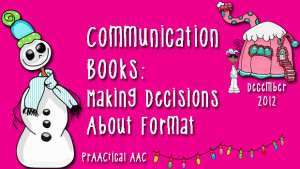
Four-year-old Josiah had a tiny one that was clipped to his belt loop so it was handy all throughout his day in preschool. Mr. Allan, who was hemiplegic and used a manual wheelchair, liked to keep one underneath his right thigh so he could grab it quickly whenever he wanted to talk. Dougie’s was big, really big, and he carried it under his arm wherever he went. Marla’s was a permanent fixture on her wheelchair laptray, and if she came without it because a caregiver forgot to put it on, it was likely to be a very l-o-n-g day. Geena’s looked like a DayPlanner and had it’s own special compartment in her purse. What are we talking about? Communication books, of course. And despite the fact that they all served the same general purpose, the communication books referenced in these examples couldn’t have looked more distinct. In this week’s post,... [Read More...]
Filed under: Strategy of the Month
Tagged With: binder, communication book, flipbook, format, page fluffer, tabs, wallet
December 14, 2012
by Robin Parker -
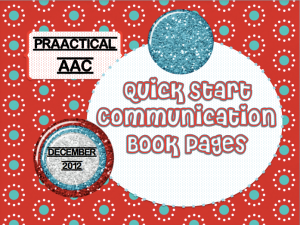
As we are talking about communication boards this month, we wanted to share a great free resource that is available to everyone. ConnectABILITY is a virtual community and website focused on lifelong learning and support for people who have an intellectual disability, their families and their support networks. It is based in Canada and funded by a grant from Ronald McDonald House Charities. We have used many resources from ConnectAbility. We love that you can get information for all ages (children through senior adults). We love the multimedia formats. We have listened to podcasts, read about community and participated in interactive learning. But we absolutely love the Visual Engine which helps you learn about and make visual supports. We LOVE the way you can easily create communication boards and recently realized there are easy ways to add photos, symbols, or even your own pictures or photos. The ‘ease of use’... [Read More...]
Filed under: Strategy of the Month
Tagged With: communications page, resources
December 1, 2012
by Carole Zangari -
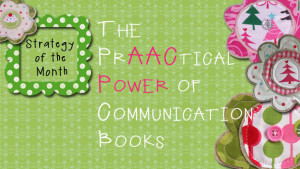
There’s something about the month of December that makes us a bit nostalgic. As we prepare for the holidays, our thoughts drift to the past. Simpler times. Tradition. The way things used to be. And, so, for our Strategy of the Month, we step away from the latest app or fanciest SGD and turn our attention to one of the tried-and-true tools from the past: Communication books. They used to be ubiquitous but now they’re becoming almost a rarity. We’ve decided to focus on them for a couple of reasons, but the main one is to spread the word that it doesn’t take a sizeable budget to give someone access to real language. If you have access to a computer and printer, you can make a really robust communication book for little or no money. It seems so simple: Put some words and pictures in a book. Show someone how... [Read More...]
Filed under: Strategy of the Month
Tagged With: communication book
November 24, 2012
by Robin Parker -
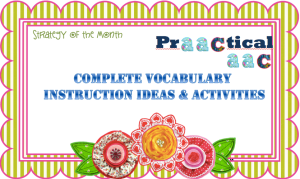
We love incorporating new vocabulary into fun motivating activities even when we are doing direct vocabulary instruction. We embed new vocabulary in activities using all of the language modalities- reading, writing, talking, and listening. We use planned vocabulary instruction activities as well as unexpected opportunities to embed new vocabulary. We like to stay within the theme of vocabulary learning but try and stay flexible in case a perfect opportunity arises that allows us to reflect back on an old vocabulary theme or mention a future planned theme. The main goal of direct vocabulary instruction is more than learning a new list of words, it is learning robust word knowledge so that language skills can be broadened. Consider these vocabulary instruction steps by Robert Marzano. These steps were not specifically developed for AAC users but if we add a language focus and a little more fun and active participation, they... [Read More...]
Filed under: Strategy of the Month
Tagged With: language, vocabulary instruction
November 17, 2012
by Carole Zangari -
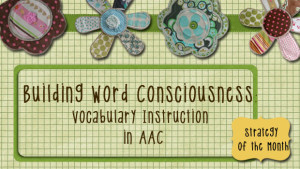
The mind is not a vessel to be filled but a fire to be kindled. Plutarch Last week, Robin discussed some strategies and activities for teaching new words to individuals who are at the earlier stages of language learning. This week, we move ahead and address semantic instruction for individuals who regularly create sentences to express themselves. One of my favorite things about working with AAC learners at this level is the opportunity for having metalinguistic conversations. Getting them to think and talk about language can accelerate their learning. Here are some prAACtical thoughts on how this relates to semantics with a focus on building word consciousness. We’re all familiar with music appreciation and art appreciation. I always think of word consciousness as a sort of like word appreciation. It refers to an awareness that words are the building blocks of language and that they can be examined and manipulated... [Read More...]
Filed under: Strategy of the Month
Tagged With: intervention, language therapy, new words, semantics, vocabulary, word consciousness
November 10, 2012
by Robin Parker -
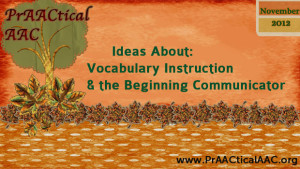
Vocabulary instruction is a topic not often discussed for beginning communicators. As we work with beginning communicators the primary focus is often vocabulary selection for communication displays. This is understandable as the beginning communicator has many needs, but that is no excuse for leaving out vocabulary instruction. Direct vocabulary instruction helps expand broader vocabulary selection options, literacy skills, and world knowledge. With that in mind, see below for vocabulary instruction philosophies, notes, and activities for the beginning communicator. Please let us know about your favorite vocabulary instruction activities. Vocabulary Instruction for the Beginning Communicator: 5 Philosophies Vocabulary instruction involves a systematic TEACHING process. Add vocabulary as an activity on the daily schedule and then have a mini-schedule for the specific vocabulary instruction activities for that day. Carole introduced general steps for vocabulary instruction last week. For the beginning communicator, also apply an errorless learning paradigm. Gradually, add comprehension checks, but... [Read More...]
Filed under: Strategy of the Month
Tagged With: beginning communicator, communication, language, language facilitation activities, teaching, vocabulary
November 3, 2012
by Carole Zangari -
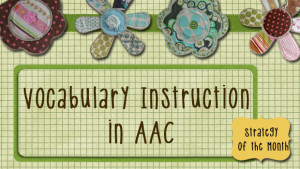
For all of us, the process of how we learn to use words begins with the expression of our own intents. Initially, we use words, pictures, or signs to make our wants/needs known but that soon develops into social exchanges, true conversations, stories, and more. For some of our AAC friends, the path to a rich lexicon can be convoluted and bumpy. Our November Strategy of the Month posts will focus on vocabulary instruction giving both general principles that should guide our teaching and specific considerations for communicators at different levels. As SLPs, we should be champions for a comprehensive approach to semantic instruction in AAC. Much of what we already know for teaching semantics to people who speak can be applied quite nicely to individuals with AAC needs. Certainly some things will need to be adapted, but that’s not the real issue. We’ve noticed that SLPs sometimes forget to... [Read More...]
Filed under: Strategy of the Month
Tagged With: intervention, new words, semantics, strategy, vocabulary, word learning
October 27, 2012
by Robin Parker -
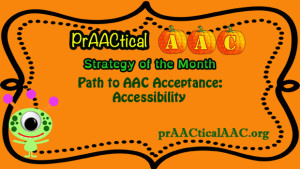
It is AAC Awareness Month and everyone has really been spreading the word and helping to build AAC acceptance. Participation barriers continue to prevent full AAC acceptance. In order to help combat these obstacles it is necessary to talk about them, deconstruct them, and attempt to build solutions. So after going over attitudinal barriers and information barriers, we need to discuss accessibility barriers. It’s a shame that there are so many barriers to making AAC work, but we know that with awareness comes improvement. Barriers of accessibility can be about motor, sensory, cognitive, literacy, or communication/language issues. For this discussion though the focus is on accessing AAC to learn a comprehensive language in ALL modalities (i.e., talking, listening, reading, & writing). The prevention of access to a comprehensive system is usually tied in to assumptions about cognitive and literacy skills. Although it seems that most professionals realiize that there... [Read More...]
Filed under: Strategy of the Month
Tagged With: AAC Awareness Month, Barriers, Path to AAC Acceptance: Accessibility









